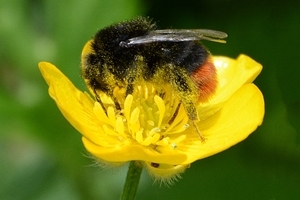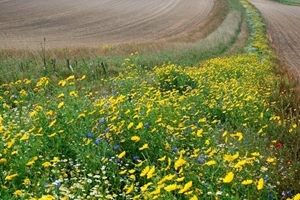Key points
- This study looked at wildflower species in separate blocks and examined how attractive each was to foraging bumblebees and solitary bees.
- Forty wild bee species were recorded, and 45 wildflowers studied.
- The top 14 wildflower species were visited by 37 out of the 40 wild bee species and accounted for over 99% of observed foraging visits in the study.
- A proposed wildflower mix based on this study contains 18 species and includes attractive foraging flowers for all the bee species recorded.
- Only two of these species are included in Defra’s currently suggested nectar or flower rich margin mixes.
Background
 Pollination is critical for farming many crops, with much of this carried out by pollinating insects such as bees. Because it is the one many people know best, we often think of the honeybee as being responsible for most pollination, however recent studies have shown that in Britain, honeybees perform less than a third of pollination. The majority by far is down to wild bees, being bumblebees and solitary bees. Wild bees are often better pollinators than honeybees, transferring more pollen per visit, and a more diverse mix of pollinator species can improve crop yields.
Pollination is critical for farming many crops, with much of this carried out by pollinating insects such as bees. Because it is the one many people know best, we often think of the honeybee as being responsible for most pollination, however recent studies have shown that in Britain, honeybees perform less than a third of pollination. The majority by far is down to wild bees, being bumblebees and solitary bees. Wild bees are often better pollinators than honeybees, transferring more pollen per visit, and a more diverse mix of pollinator species can improve crop yields.
Across Europe, insects are declining at an alarming rate and, following this trend, wild bees are declining in Britain. Ironically, the main driving force behind these declines is thought to be the intensification of the agriculture that depends on them. The loss of flower-rich natural habitats, safe nesting sites and the increased use of pesticides are all thought to have impacted bee populations.
Agri-environment schemes aim to counteract some of these effects, with one of the tools being the sowing of various wildflower mixes assumed to be beneficial to bumblebees and other wild bee species. However, research suggests that a large proportion of UK bee species do not benefit from these pollinator mixes. This PhD study looks at which wildflower species attract which bee species.
What they did
 Working with Emorsgate Seeds on a wildflower farm near Bath, the PhD student was able to monitor plots of 44 different wildflower species. This unusual situation offered wild bees a choice of species to forage on, and scientists were able to conduct surveys to identify which bee species chose to forage on which wildflower species.
Working with Emorsgate Seeds on a wildflower farm near Bath, the PhD student was able to monitor plots of 44 different wildflower species. This unusual situation offered wild bees a choice of species to forage on, and scientists were able to conduct surveys to identify which bee species chose to forage on which wildflower species.
Plant species were monitored from April to August to identify segregated areas of single species. Study lines (called transects) were selected through these strips of wildflowers, and bee monitoring surveys were carried out when walking these routes. Transects were walked on two consecutive days, when weather conditions were good enough for bees to be actively foraging. The plants themselves were also monitored to note how many were flowering, and each plant species was surveyed for bees when in peak flower (at least 60-70% plants in flower).
Bee species were identified either in the field if possible, or later in the laboratory if necessary. The number of different bee species, and abundance of each, was analysed with respect to the type of wildflower species they were on.
What they found
Suggested wildflower mix for
maximum wild bee diversity |
- Kidney vetch
- Harebell
- Greater knapweed
- Rough chervil
- Pignut
- Bindweed
- Smooth hawksbeard
- Wild carrot
- Meadow cranesbill
- Hedgerow cranesbill
- Musk mallow
- Wild marjoram
- Poppy
- Primrose
- Charlock
- Perennial sow-thistle
- Dandelion
- Scentless mayweed
|
Over the course of the study, 1,691 wild bees of 40 different species were observed foraging. 32 of these were solitary bees, six were true bumblebee species and two were parasitic or cuckoo bumblebees. The most common species recorded was the red-tailed bumblebee, with the most common solitary bees being mining bees.
The student surveyed 45 wildflower species and found solitary bees foraging on 30 of these, and bumblebees on 27. Wildflower species were ranked in order of their attractiveness to the widest range of bee species (bee “richness”). The top 14 species were visited by 37 out of the 40 wild bee species recorded and accounted for over 99% of the individual bee foraging sightings.
Of these 14, the flower species with the highest bee richness were smooth hawksbeard, dandelions, and the meadow and hedgerow cranesbills. These were followed closely by field bindweed and greater knapweed. The relative importance of different wildflowers to bees changed throughout the year as the various species flowered. The scientists mapped this importance in terms of both the number of species and abundance of bees for both solitary bees and bumblebees throughout the year, to identify which species offer the most attractive foraging to most bee species for longest.
Red-tailed bumblebees foraged on the widest range of wildflowers, being seen on 18 different species. Buff-tailed/large earth bumblebees were a close second, foraging on 17 species. Both these bees visited greater knapweed the most (38% and 27% of their visits respectively were to that species). In contrast, some species foraged on a much more limited range of wildflowers. For example, almost all (99%) of the small garden bumblebee visits observed were to kidney vetch.
Examples of species that
are attractive to solitary bees |
- Smooth hawksbeard
(Crepis capillaris)
- Primrose
(Primula vulgaris)
- Wild carrot
(Daucus carota)
- Hedgerow cranesbill
(Geranium pyrenaicum)
- Rough chervil
(Chaerophyllum temulum)
|
The scientists used their findings to suggest a possible mix of 18 wildflower species that would be attractive to a wide range of wild bee species. Unfortunately, some of the species are weeds and therefore unlikely to be sown; these include, bindweed, charlock and perennial sow-thistle.
What does this mean?
This study is the first to look at wildflower species separately and identify which are most beneficial to bees. Previous work has studied mixtures of wildflowers, so this separation allows us to identify which specific wildflower species bees are choosing to forage on. The study also identified the importance of some weed species that may occur naturally and shows that, provided these are not causing an agronomic problem, they should be left unchecked.
Using their results, the scientists are now trialling two new seed mixes that would provide attractive foraging resources to all 40 bee species recorded in the study. This is needed because the flower mixes that are currently suggested by Defra either as the nectar flower mix or the flower-rich margin/plot mix contain only one each of the 18 species found to be most attractive. The new mixes are being compared to the two existing Defra recommendations.
Example species that are
attractive to bumblebees |
- Kidney vetch
(Anthyllis vulneraria)
- Meadow cranesbill
(Geranium pratense)
- Smooth hawksbeard
(Crepis capillaris)
|
It is important that new mixes are trialled to understand how practical they may be to use, both in terms of handling and seed establishment, but also considering that some species, for example field mustard, are weeds, and therefore their management in a farming context is important.
Read the original paper
Nichols, R.N., Goulson, D., & Holland, J.M. (2019). The best wildflowers for wild bees. Journal of Insect Conservation, 23: 819 doi: 10.1007/s10841-019-00180-8
Rachel Nichols was funded by a NERC CASE studentship (NE/P009972/1) with additional support from the Game & Wildlife Conservation Trust. The supervisors are Prof Dave Goulson (University of Sussex) and Prof John Holland (GWCT).